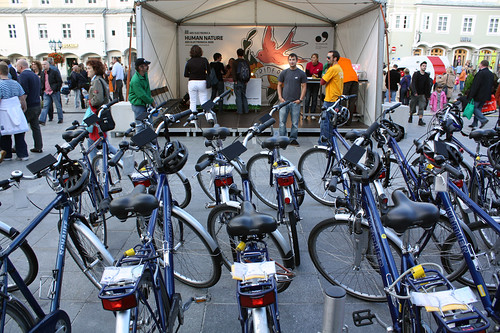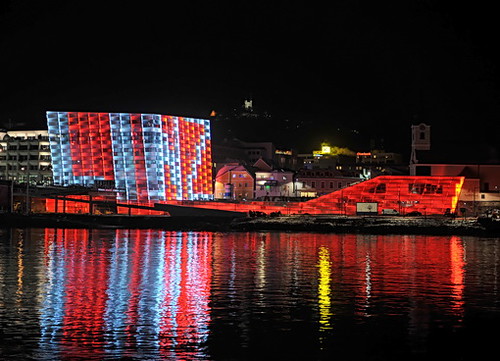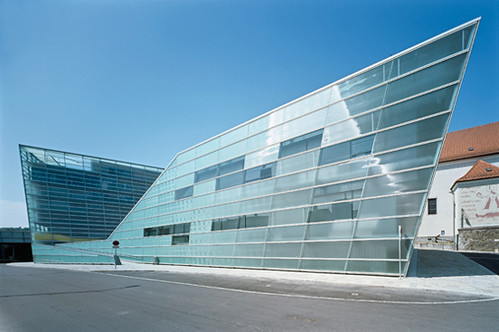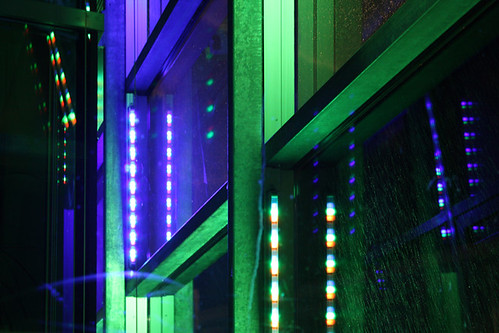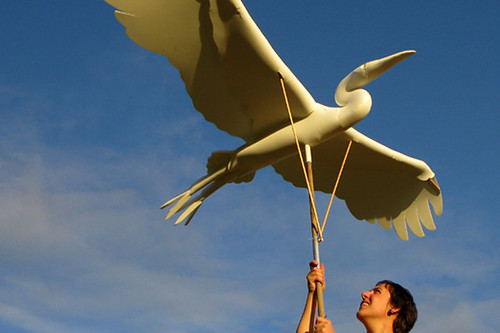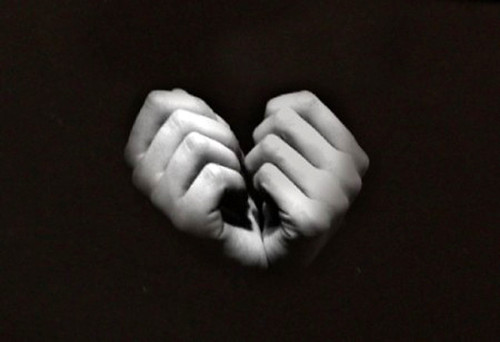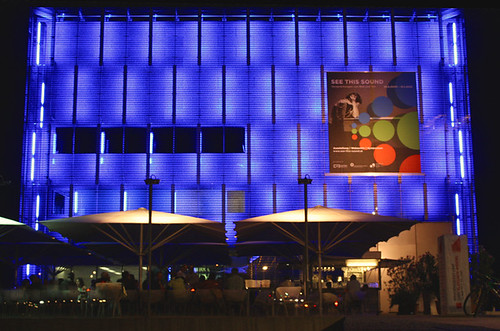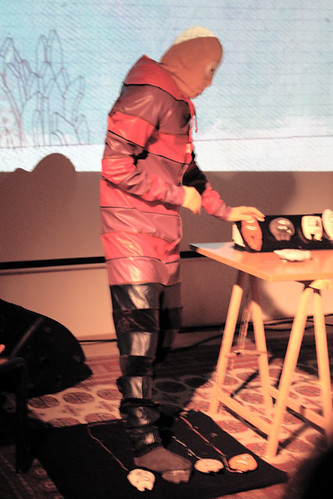A highlight of the final days of Ars Electronica was Rider Spoke, a project by the UK-based collective Blast Theory. Mixing interactive media, installation, live performance, gaming and digital broadcasting, Blast Theory is perhaps best known for Kidnap, in which the winners of a lottery were abducted and held in a secret location for 48 hours. Rider Spoke extends the idea of the group’s search games Can You See Me Now? and Uncle Roy All Around You by asking each participant to ride a bicycle throughout a city after dark, with earphones and a handheld computer mounted on the handlebars.
I struck out away from the start point in the Hauptplatz and, as the sun was setting, pushed up a steep hill overlooking the Danube. While I cycled, melancholic music played and an earnest female voice asked me to reflect on a personal moment in my life and to find a unique “hiding place” where I could record a private response.
The computer screen functions as a positioning device that identifies available hiding places. It also alerts you to nearby source locations of recorded answers by other cyclists. These answers can only be heard on the spot where they were recorded, connecting you to the very recent reflections of anonymous participants. My time on the bike was limited to about an hour — probably due to the battery life of the device — and I came away wanting to be asked more questions and to explore more of the city. Rider Spoke allows for an engagement with the particular context of a city in potentially deep conceptual and emotional ways. My only critique of the system is that it did not pair the listener’s native language with the reflections of other participants speaking the same language.
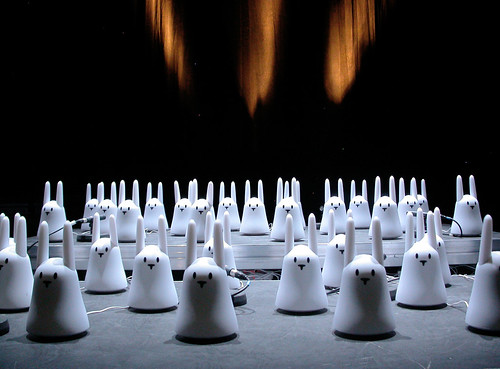
Antoine Schmitt and Jean-Jacques Birgé, NABAZ'MOB at Ars Electronica. Photo: Antoine Schmitt and Jean-Jacques Birgé
I can’t claim to have seen everything performative at the Festival, but did see most of the Pursuit of the Unheard program, comprised of performances by the Prix Ars Electronica Digital Musics prizewinners. NABAZ’MOB by Antoine Schmitt and Jean-Jacques Birga is an opera composed for 100 Wi-Fi equipped plastic bunnies that can be programmed to flash colored lights in their bellies, make twinkly music and swivel their ears. The music and choreography, transmitted via Wi-Fi and founded on repetition and time delay, appeared to be controlled by both the artists and the individual and collective rabbits. An earlier version on video of NABAZ’MOB can be seen here:
Other standouts were Tristan Perich’s Active Field for ten violins and ten-channel 1-bit music, performed by Perich and members of the Bruckner Orchester Linz and digitally-created, curtain-like visuals by Kenneth Huff accompanying Alan Hovhaness’ Lousadzak (Coming of Light). Bill Fontana’s Speeds of Time, a deconstruction of the sounds of Big Ben, was heard outdoors at Bruckner House (also as an installation across the river in the Pfarrkirche Urfahr). This arresting piece is a 12-hour multi-track recording made of a sound sculpture installed at Westminster, which derived from sensors and microphones attached to the clockwork mechanism and near the bells. A recording of Speeds of Time can be heard here.
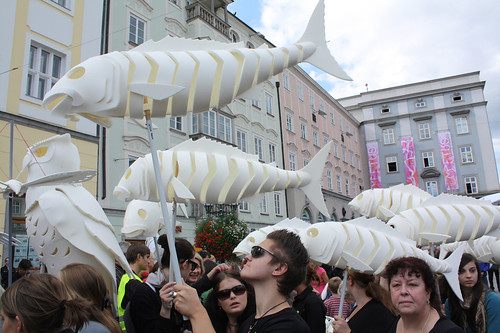
Flut Fish at Ars Electronica. Photo: Bruce Charlesworth
FLUT (Flood), mentioned in an earlier post, happened on September 5. The lead-in to the main performance was Die Prophezeiung (The Prophesy), during which performers and volunteers puppeted a seemingly endless array of animals made of white upholstery foam. For several hours in the afternoon, everything from snails to T-rexes milled through huge crowds in the Hauptplatz and nearby streets. The puppets were meticulously observed and crafted for shape and movement, and were entertaining to watch. The evening performance, Die Arche (The Ark), took place along the banks of the Danube. This part of FLUT was a mishmash of fireworks, browbeating orchestral music, declamatory videos, floating houses and icebergs. I couldn’t get into it.
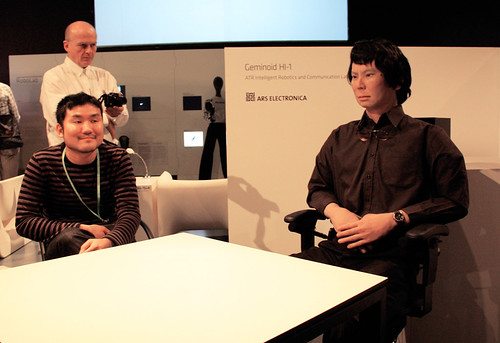
Hiroshi Ishiguro, Geminoid H1-1 at Ars Electronica. Photo: Bruce Charlesworth
Finally, I went to a demonstration of Geminoid HI-1 at the Ars Electronica Center. Hiroshi Ishiguro talked a bit about his creation, a sour-faced robot replica of himself that he uses to remotely give lectures in his stead at the University of Osaka. As Ishiguro went upstairs to sit at the control console, several of us in the small audience moved our chairs close to the table opposite Geminoid, in order to ask questions. Once activated, the robot looked around, its mouth opening and closing like a distressed fish. When someone observed that its rather intense facial expressions made it seem a bit frightening, the robot (Ishiguro on microphone) seemed surprised and a bit hurt. Hard questioning of Ishiguro’s goal to imitate human form and behavior were dodged, as was one query about a romantic scenario between two controllers of opposite-sex Geminoids.
